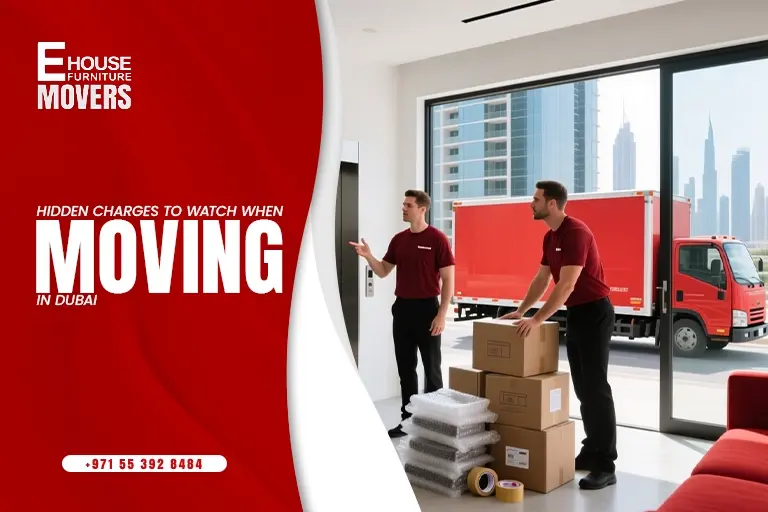Apartment movers in Dubai provide better results when the relocation is carried out in a single, predictable sequence. Apartment movers in Dubai who confirm permissions in advance, reserve the service elevator before the move, install solid hall and lift protection, and implement a clear labelling system for all rooms create a fast and low-stress move that respects neighbours, averts damage claims, and keeps elevator cycles short. In a 2BHK high-rise, the limitations are structural – shared corridors, limited service elevator windows, congestion in loading bays, so success is achieved by strict sequencing – permits first, elevator and loading bay second, protection third, and a plan for room-by-room packing and staging that demonstrates control over the elevator like a production line.
Pro-tip: Write a paper of truth about your move (date, elevator window, loading bay slot, route map, contacts). Print two copies, one for reception/security, and tape one inside your apartment door.
Table of Contents
ToggleStep-by-Step Plan (Brief Overview).
- Permissions/NOC
- Booking of elevators and loading-bays.
- Hallway/lift protection
- Labeled the packing room to room.
- Zone-batched elevators.
- Repeat the order at delivery.
Pro-tip: Make a checklist with these six steps and cross them off one by one. In case you need to skip a step, wait until that section is fixed.
Step 1: Obtaining Building Permissions and NOCs.
Start with the approvals of both properties’ move-out and move-in, since these approvals determine the only windows when common areas and the service elevator can be used. Provide the documentation required by the building’s management, including tenancy information, Emirates ID (when necessary), contacts of the mover/supervisor, and documents for public liability cover (when asked). Also, request written information on permissible dates, quiet times, and limitations on materials, trolleys, or protective covers. Request management for the service elevator position, the allowed pathway of leaving your apartment to the lift, and the loading bay beyond it, and any restrictions regarding lift attendants. Store all approvals as PDFs and forward them to your team members so that they all work from the same page.
Pro-tip: Make a common folder called NOC + Elevator Booking and drop all the PDFs, emails, and route plans in it; send it to the building management and your assistants.
Step 2: Book the Service Elevator and the Loading Bay.
Book the service elevator and slot of the loading bay as far in advance as possible; make these the heartbeat of your move. Ask to have an exclusive elevator window where possible in a building, verify the time of starting and finishing, and inquire whether a lift operator is needed. Measure the width of the elevator door, the depth of the car, and the height of the car, and then compare those to your largest objects, like a sofa, a wardrobe, a mattress, and a table, and determine whether some part of the item needs to be disassembled or loaded diagonally. Reserve parking of loading-bays with cones or a marshal where necessary, confirm height limits of trucks, and negotiate on the position of the loading-bays where the items may be staged without obstructing fire doors. Reconfirm both bookings forty-eight hours before the move and print the confirmations as a security measure.
Pro-tip: Plan early (time each empty elevator round-trip the day before). Being aware of the bottom line enables you to maintain live cycles of less than five minutes.
Step 3: Plan Out Quantities and Order Materials
Estimate quantities for a typical 2BHK so you do not run out of time on move day. A practical baseline is 15-20 small, 15-20 medium, 8-12 large cartons, 2-4 dish packs with cell dividers, and 4-6 wardrobe boxes. Add 8-12 moving blankets, floor runners/ram board long enough to cover the entire path, 8-12 foam corner guards, 2 door jam sleeves, cardboard or quilted lift liners, and caution signs or cones. Round out the kit with bubble or foam sheets, stretch wrap, 2-3 mil tape and tape gun, zip ties, zip bags for hardware, bold room labels in set colors, and optional QR stickers that link to a simple inventory sheet in the cloud.
Pro-tip: Order 10% more cartons and one extra roll of tape than your estimate – overruns occur in the last hour.
Step 4: Measure Access and Develop Route Map
Walk the exact route a box will take: apartment threshold, corridor turns, service-elevator door, lift interior, lobby exit, loading bay. Measure tight points – door frames, narrow bends, elevator opening – and compare to the largest items. Note thresholds that require small ramps, corners requiring temporary removal of door stops, and areas where a spotter must stand to avoid wall strikes. Draw a basic route map and share it with helpers so everyone knows about staging zones, clear path areas, and the elevator queue point.
Pro-tip: Tape a printed route map at your door and at the lift lobby; it prevents well-meaning helpers from improvising the route into a longer one.
Step 5: Declutter and Stabilize Appliances
Pre-pack by reducing volume 10–20% through donation, sale, or recycling; fewer boxes directly reduce elevator cycles and corridor congestion. Stabilize appliances and electronics: defrost and dry the refrigerator 24 hours before the move, drain washing-machine hoses and secure them, remove printer ink cartridges, and coil/bag cables with a quick photo of their connections to speed reassembly. Empty liquids from drawers, seal toiletries, and group restricted items according to building policy so nothing breaches house rules in common areas.
Pro-tip: Pack a “Hazards/Leaks” tote (taped shut) that travels last and never enters the lift if the building forbids it; move it by hand via approved routes.
Step 6: Install Hallway, Lobby, and Lift Protection
Before the first box moves, install protection in this order to keep crews rolling continuously: floors → corners/walls → door jambs → lift liners → signage. Lay floor runners or ram board along the full route and tape edges; add anti-slip ramps at thresholds. Fit foam corner guards at turns, place corrugated panels on narrow walls, and sleeve door jambs at your apartment and the service elevator entrance. Line the elevator interior—three walls and the rear panel—with cardboard or quilted blankets, then place signage at corridor ends and the lobby (“Move in progress,” “Use alternate lift,” “Caution—floor protection”). Finish protection completely before loading; partial coverage leads to scuffs and delays.
Pro-tip: Keep a “protection cart” (tape, spare guards, extra runner) parked by the lift for quick patching when edges lift or corners shift.
Step 7: Build a Color-Coded Labeling and Inventory System
Adopt a rigorous identification method so every box and part announces its destination instantly. Assign colors per room—Living (Blue), Bedroom 1 (Green), Bedroom 2 (Yellow), Kitchen (Red), Bath (Purple), Balcony/Store (Grey)—and print large labels. Combine color with a box number and a handling tag using a consistent code such as K-07-Fragile. Place labels on two sides and the top; apply “First-Open” to one or two boxes per room (bedding, toiletries, kettle, chargers); and use “Do-Not-Load” for items staying behind. If using QR stickers, link each code to a cloud sheet listing contents and photos, which lets you verify fragile/high-value items without opening cartons at the curb.
Pro-tip: Keep a label legend taped inside the lift cabin—new helpers understand the system in seconds.
Step 8: Room-by-Room Packing with a Fixed Micro-Sequence
Treat each room like a mini-project that provides stable, well-marked loads. Living room – remove sofa legs where possible, blanket wrap bulk items, roll and tie rugs, protect artwork/mirrors with corner pieces, and pack TV inside foam with a tight carton, putting remotes/cables inside that box. Bedrooms: hang up clothes into wardrobe cartons, slide mattresses into protective bags with edge guards, wrap headboards & frames, tape a small pouch of bolts and brackets to the bed components for easy reassembly. Kitchen: use dish-packs with cell dividers, store plates vertically, wrap glasses individually, and double-bag oils/spices before labeling “Up-Right.” Bathroom/Utility: Tape caps on toiletries and use leak-proof bags, drain and cap machine hoses, and segregate chemicals per building rules. Balcony/Store: disassemble shelves, bundle tools, cap sharp edges, and clean outdoor cushions to prevent odor transfer.
Pro-tip: Put all hardware pouches inside one bright-colored “Parts Box” that never leaves the lift area until the last bed is built.
Step 9: Stage by Zones and Control Elevator Cycles
Keep the service elevator productive by feeding it single-room trips. Stage the next load at the corridor entrance nearest the lift—never across a fire door—and send all Green (Bedroom 1) or all Red (Kitchen) boxes together so they land in the correct rooms without intermediate sorting. Aim for round-trips of ≤ five minutes during peak loading by ensuring the car is ready when it arrives, the path stays clear, and the next zone waits at the threshold. Track loads on a tally sheet as they enter the lift, reconciling box IDs so nothing goes missing between the apartment and the truck.
Pro-tip: Use a kitchen timer clipped to the lift liner; audible five-minute cycles keep everyone moving without nagging.
Step 10: Mirror the Sequence at the Delivery Building
Reinstall protection at the destination before the truck opens; unsheltered lobbies are where most scuffs occur. Unload in the same zone order as loading—Bedrooms, then Living, then Kitchen, then Balcony/Store—so the elevator continues to carry single-category trips and the receiving team places boxes directly into the right rooms. Position “First-Open” boxes prominently and reassemble beds immediately so the home functions the first night; décor and hanging can wait until essential zones are operational.
Pro-tip: Lay each room’s “First-Open” box on the bed or kitchen counter—never on the floor—so it cannot be buried.
Step 11: Run a Move-Day Timeline with Roles and KPIs
Set a simple schedule everyone can follow. 07:30–08:00: install protection, place signage, and brief roles (lift operator, hallway spotter, loaders, inventory checker). 08:00–10:30: run zone-batched elevator cycles with a visible target for round-trip time and a rule that corridors remain clear; the spotter maintains the route while loaders prepare the next batch. 10:30–11:00: remove debris, photo-verify protected surfaces, obtain the security sign-off, and depart for delivery, where protection, zone unloading, and essentials setup repeat. Practical KPIs—stay within the elevator booking times, cap idle door-open minutes, finish bed setups before dusk—keep the day on track.
Pro-tip: Print the timeline as a one-page clipboard sheet; have the spotter tick milestones and times as they happen.
Step 12: Protect People with Sensible Ergonomics
Use handling practices that protect movers and preserve pace. Keep single-person carries near a comfortable threshold (about 23 kg under easy conditions); heavier or awkward pieces move on dollies or by team lift to maintain control and clear sightlines through lift doors. Travel in straight paths, avoid twisting under load, and place items at knuckle height on carts to minimize strain during transfers. Do not stack boxes above shoulder height inside the elevator; secure tall stacks with a strap, and station a spotter at thresholds and ramps. If rain is possible, deploy non-slip ramps and shoe covers, and towel-dry wet patches quickly to keep the path safe.
Pro-tip: Color-tape dolly handles and straps; bright handles prevent misplacement during fast turnarounds.
Step 13: Unpack Essentials First and Close Out Cleanly
At the destination, unpack in the order that stabilizes the home quickly: beds and bedding first, then bathroom essentials, then the kitchen’s “First-Open” items, followed by kids’ spaces or workstations, and décor last. As cartons empty, match box IDs to your checklist, and note damage while the protection is still in place. Flatten and recycle cartons, collect blankets/runners/corner guards/lift liners for return or storage, and remove signage and restore corridors. Take final photos of the path and interior of the elevators and file with approvals and booking confirmations; the record helps to resolve questions quickly if management asks for proof of compliance.
Pro-tip: Keep a clear plastic folder with a sign “Move Closeout” to hold sign-offs, final photos, and receipts. This is your ready file for deposit returns or building audits.
Read More: Apartment Movers in Dubai (1BHK): Crew Size, Box Counts, and Timelines
Conclusion
A 2BHK high-rise move in Dubai runs on a predictable chain: permissions, elevator and loading-bay reservations, full-path protection, disciplined labeling, room-by-room packing, and mirrored zone cycles at delivery. When Apartment movers in Dubai honor that order, the elevator turns quickly, hallways stay unmarked, boxes land in the correct rooms the first time, and beds are built before the booking ends. Use this guide as your operational script, keep the route protected from the first minute to the last, and let the color-coded labels and five-minute elevator cycles do the heavy lifting of speed and accuracy.




